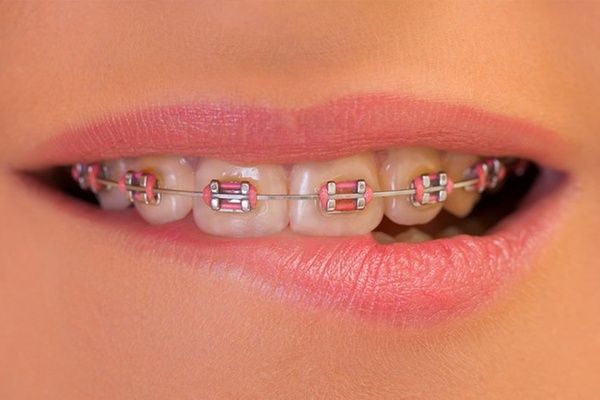Teenage years are a time of transformation, growth, and self-discovery. For many teenagers Teen Braces are one aspect of this journey involves orthodontic treatment in the form of Teen Braces. In this comprehensive guide, we will explore everything you need to know about teen braces, from their types and benefits to the experience of wearing them and achieving a confident smile.
Types of Teen Braces
1. Traditional Metal Braces:
Design: Traditional metal braces consist of small metal brackets that are affixed to the front surface of each tooth. These brackets are connected by thin metal wires. Elastic bands, known as ligatures, secure the wires to the brackets.
Function: Metal braces apply continuous pressure to the teeth, gradually moving them into their desired positions. Orthodontists periodically adjust the wires and ligatures to maintain the right amount of pressure for effective teeth alignment.
Benefits:
- Effectiveness: Metal braces are highly effective at correcting a wide range of orthodontic issues, including severe misalignments.
- Durability: They are known for their durability and reliability throughout the treatment process.
Considerations:
- Visibility: Traditional metal braces are the most noticeable option, which some teenagers may find less aesthetically appealing.
2. Ceramic Braces:
Design: Ceramic braces share a similar structure with traditional metal braces. However, the brackets are made from clear or tooth-colored ceramic material, making them less conspicuous.
Function: Like metal braces, ceramic braces apply pressure to the teeth, guiding them into the desired positions. Orthodontists use clear or tooth-colored ligatures to further reduce visibility.
Benefits:
- Aesthetics: Ceramic braces are less noticeable than traditional metal braces, making them a preferred choice for Teen Braces who want a more discreet option.
- Effectiveness: They are effective in treating various orthodontic issues.
Considerations:
- Cost: Ceramic braces tend to be slightly more expensive than metal braces.
- Maintenance: Ceramic brackets may require extra care to prevent staining from foods and drinks that can discolor them.
3. Invisible Aligners:
Design: Invisible aligners, such as Invisalign, are a series of clear, custom-made trays that fit snugly over the teeth. These aligners are removable and replaced every few weeks as the teeth gradually shift in Teen Braces.
Function: Each set of aligners applies precise pressure on specific teeth to move them into alignment over time. The treatment plan is carefully designed by an orthodontist.
Benefits:
- Invisibility: Aligners are virtually invisible when worn, making them a discreet option that many teenagers prefer.
- Removability: Being removable, they allow for easier oral hygiene and the ability to eat without restrictions during treatment.
Considerations:
- Compliance: Successful treatment with aligners requires commitment to wearing them as instructed.
- Limited Treatment Scope: Not all orthodontic issues can be treated with aligners; they are most suitable for mild to moderate cases.
4. Lingual Braces:
Design: Lingual braces are similar in design to traditional metal braces, but with a key difference: the brackets and wires are placed on the back (lingual) surface of the teeth, making them virtually invisible from the front.
Function: Like traditional braces, lingual braces use wires and brackets to apply pressure on the teeth, guiding them into their correct positions.
Benefits:
- Invisibility: Lingual braces are hidden from view when you smile, making them an excellent option for teens who want the effectiveness of traditional braces without the visibility.
- Effective for Complex Cases: They can treat complex orthodontic issues as effectively as traditional braces.
Considerations:
- Comfort: Lingual braces may take some time to get used to, as they are in close contact with the tongue.
- Cost: They are typically more expensive than traditional braces
Benefits of Teen Braces
1. Improved Oral Health:
Properly aligned teeth are easier to clean and maintain. When teeth are crowded or misaligned, it can be challenging to reach certain areas with a toothbrush or floss. Over time, this can lead to plaque buildup, tooth decay, and gum disease. Teen braces gradually shift teeth into their correct positions, making it easier to maintain good oral hygiene. This, in turn, reduces the risk of cavities, gum inflammation, and other dental issues.
2. Enhanced Confidence:
Teenage years are often marked by self-discovery and social interactions. A confident smile can significantly impact a teenager’s self-esteem and how they perceive themselves. Braces help align teeth, correct bite issues, and improve the overall appearance of the smile. As a result, teenagers tend to feel more confident in their appearance, which can lead to improved social interactions and a positive self-image. This boost in confidence can extend to various aspects of their lives, including academic and extracurricular activities.
3. Functional Improvements:
Braces not only improve the aesthetics of the smile but also address functional issues. For teenagers with misaligned bites (malocclusions), braces can correct these problems. Malocclusions can lead to difficulties in chewing food properly and speaking clearly. By aligning the teeth and jaws, braces can enhance a teenager’s ability to eat comfortably and articulate words effectively. This can positively impact their overall quality of life.
4. Long-Term Benefits:
Investing in orthodontic treatment during the teenage years can yield long-term benefits. Addressing alignment and bite issues early can prevent more extensive dental problems in adulthood. Without treatment, misaligned teeth or bite problems can lead to issues such as tooth wear, jaw pain, and even temporomandibular joint (TMJ) disorders. By undergoing orthodontic treatment as a teenager, these potential problems can be mitigated or avoided, saving both time and money on future dental work.
5. Prevention of Dental Trauma:f
Teeth that protrude or are misaligned are more vulnerable to injury during sports or accidents. Teen braces can help bring these teeth into proper alignment, reducing the risk of dental trauma. This is particularly important for active teenagers who participate in sports and other physical activities.
6. Long-Lasting Results:
Once orthodontic treatment is complete and braces are removed, the results are long-lasting. However, it’s essential to wear a retainer as directed by the orthodontist to maintain the newly aligned teeth. With proper retainer use and continued oral care, the benefits of teen braces can extend well into adulthood.
The Teen Braces Experience
Wearing braces as a teenager is a journey that typically lasts from one to three years, depending on the complexity of the orthodontic issues. Here’s what you can expect:
1. Initial Placement:
When braces are first put on, there may be some discomfort as your mouth adjusts to the new hardware. Over-the-counter pain relievers and orthodontic wax can help ease any sore spots.
2. Regular Adjustments:
Throughout the treatment period, you’ll visit your orthodontist regularly for adjustments. These appointments are crucial for ensuring your teeth move into their desired positions.
3. Oral Hygiene:
Proper oral hygiene is essential during brace treatment. Your orthodontist will provide guidance on how to clean your teeth and braces effectively.
4. Dietary Adjustments:
Certain foods should be avoided to prevent damage among Teen Braces. These may include hard, sticky, or crunchy items that can break wires or brackets.
5. Maintenance:
After braces are removed, a retainer is often recommended to maintain the results and prevent teeth from shifting back to their original positions.
Conclusion
Teen braces are not just about achieving a straighter smile; they offer numerous benefits, including improved oral health, enhanced confidence, functional improvements, and long-term dental well-being. Whether your teenager opts for traditional metal braces, ceramic braces, invisible aligners, or lingual braces, Teen Braces is the journey toward a confident and healthy smile is a rewarding one. Embrace the process, follow the guidance of your orthodontist, and look forward to the day when your teenager unveils their beautiful, straightened teeth and radiant smile.



